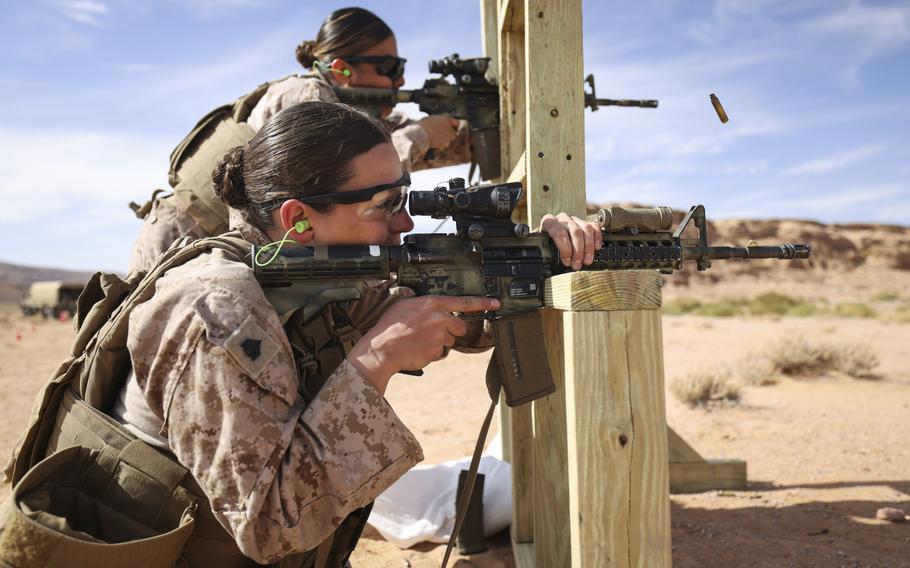
Marine Corps Sgt. Angela Scolari, front, a combat marksmanship coach assigned to 6th Air Naval Gunfire Liaison Company, Force Headquarters Group, U.S. Marine Corps Forces Reserve, fires a rifle during an all-female marksmanship subject matter expert exchange between U.S. Marines and Jordanian soldiers in Al-Quwayrah, Jordan, on Oct. 29, 2024. (Sgt. Angela Wilcox/U.S. Marine Corps photo )
WASHINGTON — Defense Secretary Pete Hegseth has ordered the secretaries of the military services to come up with a plan that distinguishes between combat-arms jobs and noncombat-arms jobs and develops physical standards that are “sex-neutral.”
“For far too long, we allowed standards to slip and different standards for men and women in combat arms [military occupational specialties],” Hegseth said Monday in a video posted on X. “That’s not acceptable. We need to have the same standard, male or female, in our combat roles.”
Hegseth, an Army National Guard veteran, came under fire before becoming defense secretary for saying women have a place in the military but not in ground-based combat jobs in special operations, artillery, infantry and armor units.
“I’m straight up just saying we should not have women in combat roles,” he argued on a podcast in November. “It hasn’t made us more effective, hasn’t made us more lethal, has made fighting more complicated.”
Questions were raised by senators during his hearing in January. Hegseth denied he ever disparaged women and said his concern was with what he believes are slipping standards and gender quotas. He said he would conduct a review of the requirements for combat positions if he became defense secretary.
“In ways direct and indirect, overt and subtle, standards have been changed inside infantry training units, [Army] Ranger school, infantry battalions to ensure that commanders meet quotas to have a certain number of female officers or female enlisted,” he said at the time.
For certain combat roles, Hegseth wrote in the memo dated Sunday that it is “essential to identify” positions that require heightened entry-level and sustained physical fitness standards. Plans must address ground combat jobs, special operations forces and specialized occupations.
Hegseth marked the document with an asterisk and included a handwritten note that “no existing standard will be lowered in the process.”
He is ordering the military secretaries to submit their proposals to the undersecretary of defense for personnel and readiness within 60 days of the memo. The secretaries of the services will provide an interim update on the development of their plans to the undersecretary within 30 days.
Full implementation of plans must occur within six months of submission, Hegseth wrote.
“This initiative aligns with my broader directive to maintain uncompromising and clear standards that ensure the continued dominance of our military,” the secretary added.
Hegseth issued another memo dated March 12 that stated the undersecretary for personnel must gather information on military standards “pertaining to physical fitness, body composition and grooming, which includes but is not limited to beards.”
Hegseth’s memo called for a review of how standards have changed and the impact of those shifts since Jan. 1, 2015. That year, then-Defense Secretary Ash Carter announced beginning in January 2016 all combat roles would be open to women.
The 2015 decision, resisted most by the Marine Corps, opened about 230,000 combat positions that were previously off limits for women.
Today, thousands of women are serving in Army infantry, armor and artillery jobs, hundreds are in combat roles in the Marines and dozens are in special operations positions across the military.
The military has long had what is largely a two-part system for physical fitness standards — routine annual fitness based on gender and age or more grueling standards for specific combat, special operations, infantry, armor, pararescue jumpers and other jobs. For some combat roles, the standards are the same for various occupations regardless of age or gender.
Hegseth wrote in his memo that the focus for occupations such as Navy divers and explosive ordnance disposal technicians should be proficiency in tasks such as water rescue, repair and demolition. This is already a requirement, according to a Navy spokesperson.
The 2024 National Defense Authorization Act, an annual law that sets expenditures and policies for the Defense Department, directed the Army to implement “higher minimum standards” for some combat troops in its Army Combat Fitness Test, or ACFT, within 18 months of the bill’s enactment.
As major combat operations were ongoing in Iraq and Afghanistan in about 2010, top Army leaders began planning for a more rigorous fitness evaluation. They believed the decades-old Army Physical Fitness Test, or APFT, placed too much emphasis on a soldier’s running ability and did not adequately gauge a service member’s ability to perform critical functions in combat, such as heaving heavy equipment or dragging a wounded trooper to safety.
The law brings the Army back in part to its original intent when it rolled out the ACFT in 2018. It was to be a gender- and age-neutral fitness assessment with scoring tiers based on the physical demands of an individual’s job.
The Army eventually developed different standards for men and women, facing pressure from Congress after studies showed fewer than half of female soldiers were passing early versions of the test.